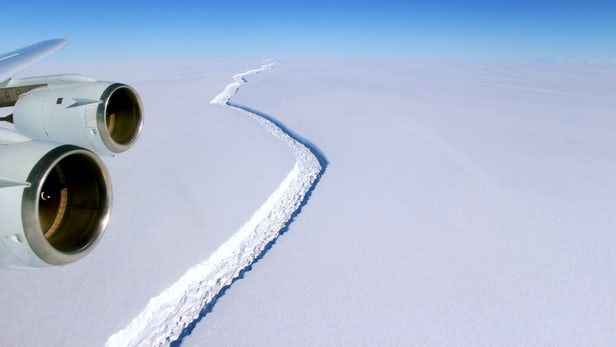Satellites keep watch as giant iceberg creeps closer to cracking

An aerial view of the crack in the Larsen C ice shelf, which is due to soon break off into one of the largest icebergs ever recorded (Credit: NASA / John Sonntag)
The Larson C ice shelf in Antarctica is creeping closer to breaking off, and when it does, it's set to form one of the biggest icebergs on record. The ESA's CryoSat is keeping watch from above, and mission scientists have now estimated the dimensions of this inevitable iceberg in-the-making, and where it might drift.
In the last few months, the crack between Larsen C and the Antarctic mainland has been growing by about 10 m (33 ft) a day, and it's speeding up. The crack now extends some 200 km (124 miles) across the ice, with a mere 5 km (3 miles) standing between it and the ocean. When it completes the journey and breaks off, the resulting iceberg will have an area of about 6,000 sq km (2,317 sq mi).
Several orbital eyes are on the ice, including the Copernicus Sentinel-1 pair, a constellation of two satellites that orbit 180 degrees apart. Sentinel-1 has been tracking the crack, while CryoSat monitors the changing height and thickness of the ice using a radar altimeter, with the aim of studying how the climate is affecting the volume of the planet's ice.
"Using information from CryoSat, we have mapped the elevation of the ice above the ocean and worked out that the eventual iceberg will be about 190 m (623 ft) thick and contain about 1,155 km3 (277 cu mi) of ice," says Noel Gourmelen, a researcher on the project. "We have also estimated that the depth below sea level could be as much as 210 m (690 ft)."
An iceberg of this size could wreak havoc if it drifts into shipping lanes or research sites, so Sentinel-1 and CryoSat will continue to monitor it after it snaps off. A few years ago, a similarly large iceberg from the Brunt ice shelf caused a bit of a scare for scientists at the Halley research base.
"Measurements from CryoSat showed that the Brunt berg was around 390 m (1,280 ft), so too thick to come close to 'shore' since the sea is shallow here," says Anna Hogg, a researcher from the University of Leeds. "As for this new Larsen C berg, we are not sure what will happen. It could, in fact, even calve in pieces or break up shortly after. Whole or in pieces, ocean currents could drag it north, even as far as the Falkland Islands. If so it could pose a hazard for ships in Drake Passage. What is certain, though, is that we shall continue to use CryoSat to keep a check on its progress."
Ongoing monitoring has helped scientists develop a general understanding of where icebergs tend to drift, which can help provide an early warning system for any potential hazards.
"Our historical effort to track large icebergs shows that those from the western Weddell Sea find their way out into the Antarctic Circumpolar Current or into the South Atlantic," says Mark Drinkwater, of the ESA."It seems that only bergs from the Ross ice shelf stay in the westward coastal current and come close to Brunt ice shelf."
Source: ESA

